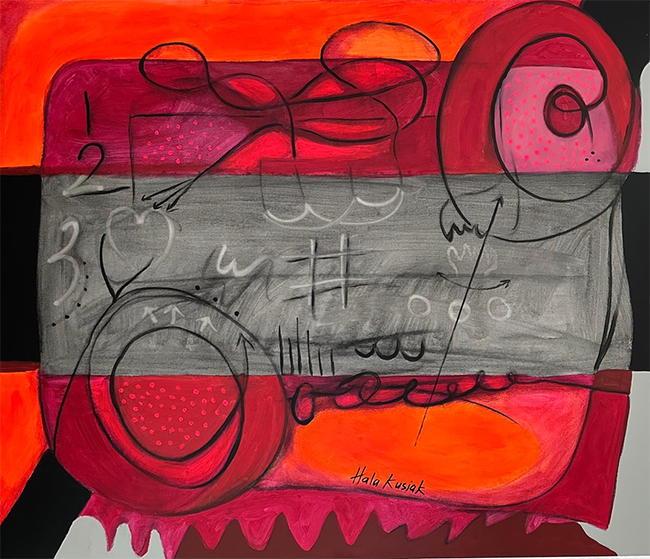Hala Kusiak doesn’t paint to impress. She paints to stir something awake. Her art doesn’t shout, but it holds steady. It waits for the viewer to notice—and then it begins to speak. What you hear depends on what you bring. Her work isn’t just for the eye, it’s for the mind and something deeper. She calls it “emotional awakening.” She’s not exaggerating.

Kusiak describes herself as an artist with a “bold and innovative outlook,” but her intent stretches beyond aesthetics. At the core of her practice is a desire to connect across time, space, and generations. She wants her art to be more than decoration. It’s meant to offer a framework for reflection—a moment to step out of the rush of daily life and see things from a new angle. Her paintings suggest a kind of internal architecture. They’re grounded in what she calls “constructional functional theory,” a phrase that might sound clinical at first, but makes sense the longer you sit with her work. It’s about structure and purpose—how form and color can become emotional tools.
One painting, Wait, lays this approach bare. It centers on a moment we all know: the ache of uncertainty, the in-between stretch where time slows and emotions stir. Using vibrant reds to suggest longing and tension, and cool grays to hold things back, the piece creates its own mood—somewhere between yearning and surrender. There are symbols throughout: numbers scattered like remnants of time, an arrow frozen mid-flight, a heart that seems unsure. It doesn’t offer an answer, and that’s the point. Kusiak isn’t trying to resolve anything for you. Instead, she’s giving space to sit with the unresolved. In her hands, waiting becomes a place, not a punishment.
Kusiak’s color palette is another story in itself. She talks about it as her “DNA.” It’s where the boldness lives. She’s not shy with pigment. Her paintings glow with saturated hues—purples pressed against yellows, deep reds holding steady beside quiet blues. The contrasts don’t compete; they work in balance. This tension and harmony echo her deeper goals: giving viewers the freedom to explore contradiction, beauty, memory, and change, all at once.
But what sets her apart isn’t just technical skill or theory—it’s her intention. Kusiak sees art as a way to bridge time. To her, every generation needs its own tools to think and feel deeply, and she wants her art to serve that function. In this sense, her work acts like a thread, connecting now to then, here to elsewhere. It isn’t locked in a single cultural or stylistic identity. It’s open-ended. That openness gives her paintings their quiet confidence.
She also challenges viewers to participate. Every corner of the canvas, she says, holds a story—but it’s not her job to explain it. That’s up to you. You’re not just a bystander, you’re a decoder. This is where her work becomes less about surface and more about invitation. You can hang her art on a wall, but it keeps working on you long after you’ve looked away.
Kusiak doesn’t just want people to admire what they see. She wants them to feel free enough to shift how they see everything else. That’s a high bar, but she reaches for it anyway. Her belief is that when people experience art in this way—actively, emotionally, honestly—they start to explore their own well-being in a deeper, more personal way. And that, for her, is the real work.
There’s a sense that Kusiak isn’t making art to fit into trends or galleries. She’s making it because she has to. It’s part of how she thinks, how she feels, how she connects. Her work is shaped by experience, by reflection, and by a drive to connect people to something lasting—something that doesn’t get old or go out of style. She doesn’t ask for attention, but she earns it.
In a time when the art world can feel noisy, Kusiak’s approach is a kind of relief. Her paintings aren’t loud, but they are clear. They leave room. They hold tension without breaking. They ask without demanding. And they reward those who choose to look closer.
You don’t have to know anything about “constructional functional theory” to feel something in her work. You just have to pause. Take a breath. And maybe, like the frozen arrow in Wait, you’ll find yourself suspended—still, alert, and open. That’s where her work begins. And maybe that’s the point.

